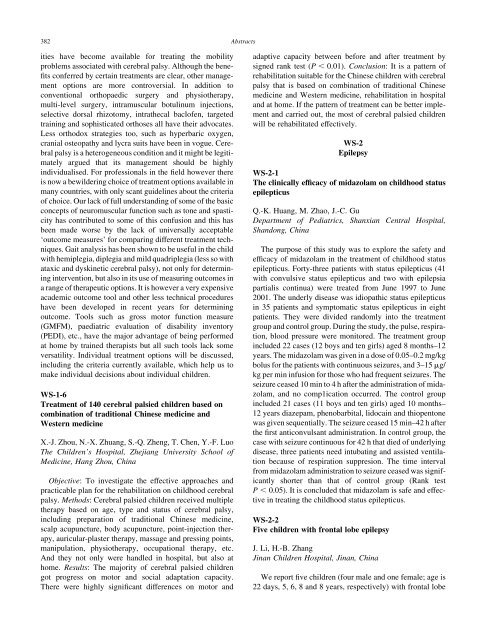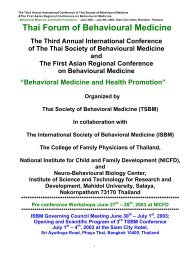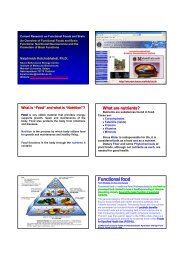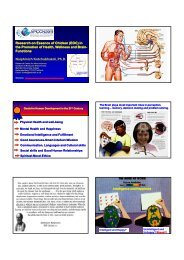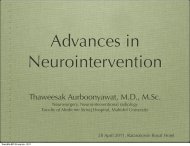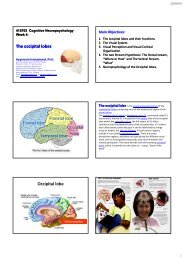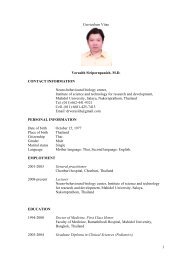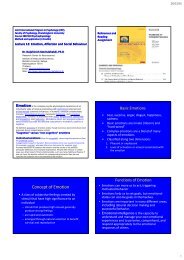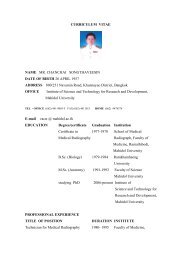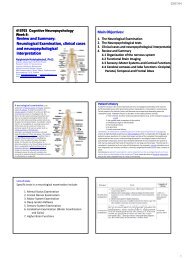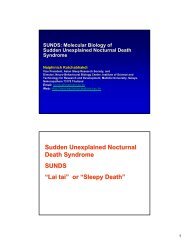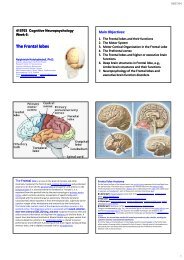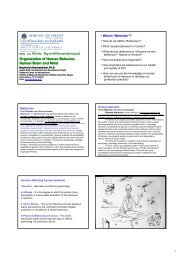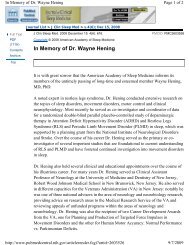PDF File - Mahidol University
PDF File - Mahidol University
PDF File - Mahidol University
Create successful ePaper yourself
Turn your PDF publications into a flip-book with our unique Google optimized e-Paper software.
382<br />
Abstracts<br />
ities have become available for treating the mobility<br />
problems associated with cerebral palsy. Although the benefits<br />
conferred by certain treatments are clear, other management<br />
options are more controversial. In addition to<br />
conventional orthopaedic surgery and physiotherapy,<br />
multi-level surgery, intramuscular botulinum injections,<br />
selective dorsal rhizotomy, intrathecal baclofen, targeted<br />
training and sophisticated orthoses all have their advocates.<br />
Less orthodox strategies too, such as hyperbaric oxygen,<br />
cranial osteopathy and lycra suits have been in vogue. Cerebral<br />
palsy is a heterogeneous condition and it might be legitimately<br />
argued that its management should be highly<br />
individualised. For professionals in the field however there<br />
is now a bewildering choice of treatment options available in<br />
many countries, with only scant guidelines about the criteria<br />
of choice. Our lack of full understanding of some of the basic<br />
concepts of neuromuscular function such as tone and spasticity<br />
has contributed to some of this confusion and this has<br />
been made worse by the lack of universally acceptable<br />
‘outcome measures’ for comparing different treatment techniques.<br />
Gait analysis has been shown to be useful in the child<br />
with hemiplegia, diplegia and mild quadriplegia (less so with<br />
ataxic and dyskinetic cerebral palsy), not only for determining<br />
intervention, but also in its use of measuring outcomes in<br />
a range of therapeutic options. It is however a very expensive<br />
academic outcome tool and other less technical procedures<br />
have been developed in recent years for determining<br />
outcome. Tools such as gross motor function measure<br />
(GMFM), paediatric evaluation of disability inventory<br />
(PEDI), etc., have the major advantage of being performed<br />
at home by trained therapists but all such tools lack some<br />
versatility. Individual treatment options will be discussed,<br />
including the criteria currently available, which help us to<br />
make individual decisions about individual children.<br />
WS-1-6<br />
Treatment of 140 cerebral palsied children based on<br />
combination of traditional Chinese medicine and<br />
Western medicine<br />
X.-J. Zhou, N.-X. Zhuang, S.-Q. Zheng, T. Chen, Y.-F. Luo<br />
The Children’s Hospital, Zhejiang <strong>University</strong> School of<br />
Medicine, Hang Zhou, China<br />
Objective: To investigate the effective approaches and<br />
practicable plan for the rehabilitation on childhood cerebral<br />
palsy. Methods: Cerebral palsied children received multiple<br />
therapy based on age, type and status of cerebral palsy,<br />
including preparation of traditional Chinese medicine,<br />
scalp acupuncture, body acupuncture, point-injection therapy,<br />
auricular-plaster therapy, massage and pressing points,<br />
manipulation, physiotherapy, occupational therapy, etc.<br />
And they not only were handled in hospital, but also at<br />
home. Results: The majority of cerebral palsied children<br />
got progress on motor and social adaptation capacity.<br />
There were highly significant differences on motor and<br />
adaptive capacity between before and after treatment by<br />
signed rank test (P , 0:01). Conclusion: It is a pattern of<br />
rehabilitation suitable for the Chinese children with cerebral<br />
palsy that is based on combination of traditional Chinese<br />
medicine and Western medicine, rehabilitation in hospital<br />
and at home. If the pattern of treatment can be better implement<br />
and carried out, the most of cerebral palsied children<br />
will be rehabilitated effectively.<br />
WS-2<br />
Epilepsy<br />
WS-2-1<br />
The clinically efficacy of midazolam on childhood status<br />
epilepticus<br />
Q.-K. Huang, M. Zhao, J.-C. Gu<br />
Department of Pediatrics, Shanxian Central Hospital,<br />
Shandong, China<br />
The purpose of this study was to explore the safety and<br />
efficacy of midazolam in the treatment of childhood status<br />
epilepticus. Forty-three patients with status epilepticus (41<br />
with convulsive status epilepticus and two with epilepsia<br />
partialis continua) were treated from June 1997 to June<br />
2001. The underly disease was idiopathic status epilepticus<br />
in 35 patients and symptomatic status epilepticus in eight<br />
patients. They were divided randomly into the treatment<br />
group and control group. During the study, the pulse, respiration,<br />
blood pressure were monitored. The treatment group<br />
included 22 cases (12 boys and ten girls) aged 8 months–12<br />
years. The midazolam was given in a dose of 0.05–0.2 mg/kg<br />
bolus for the patients with continuous seizures, and 3–15 mg/<br />
kg per min infusion for those who had frequent seizures. The<br />
seizure ceased 10 min to 4 h after the administration of midazolam,<br />
and no comp1ication occurred. The control group<br />
included 21 cases (11 boys and ten girls) aged 10 months–<br />
12 years diazepam, phenobarbital, lidocain and thiopentone<br />
was given sequentially. The seizure ceased 15 min–42 h after<br />
the first anticonvulsant administration. In control group, the<br />
case with seizure continuous for 42 h that died of underlying<br />
disease, three patients need intubating and assisted ventilation<br />
because of respiration suppresion. The time interval<br />
from midazolam administration to seizure ceased was significantly<br />
shorter than that of control group (Rank test<br />
P , 0:05). It is concluded that midazolam is safe and effective<br />
in treating the childhood status epilepticus.<br />
WS-2-2<br />
Five children with frontal lobe epilepsy<br />
J. Li, H.-B. Zhang<br />
Jinan Children Hospital, Jinan, China<br />
We report five children (four male and one female; age is<br />
22 days, 5, 6, 8 and 8 years, respectively) with frontal lobe


